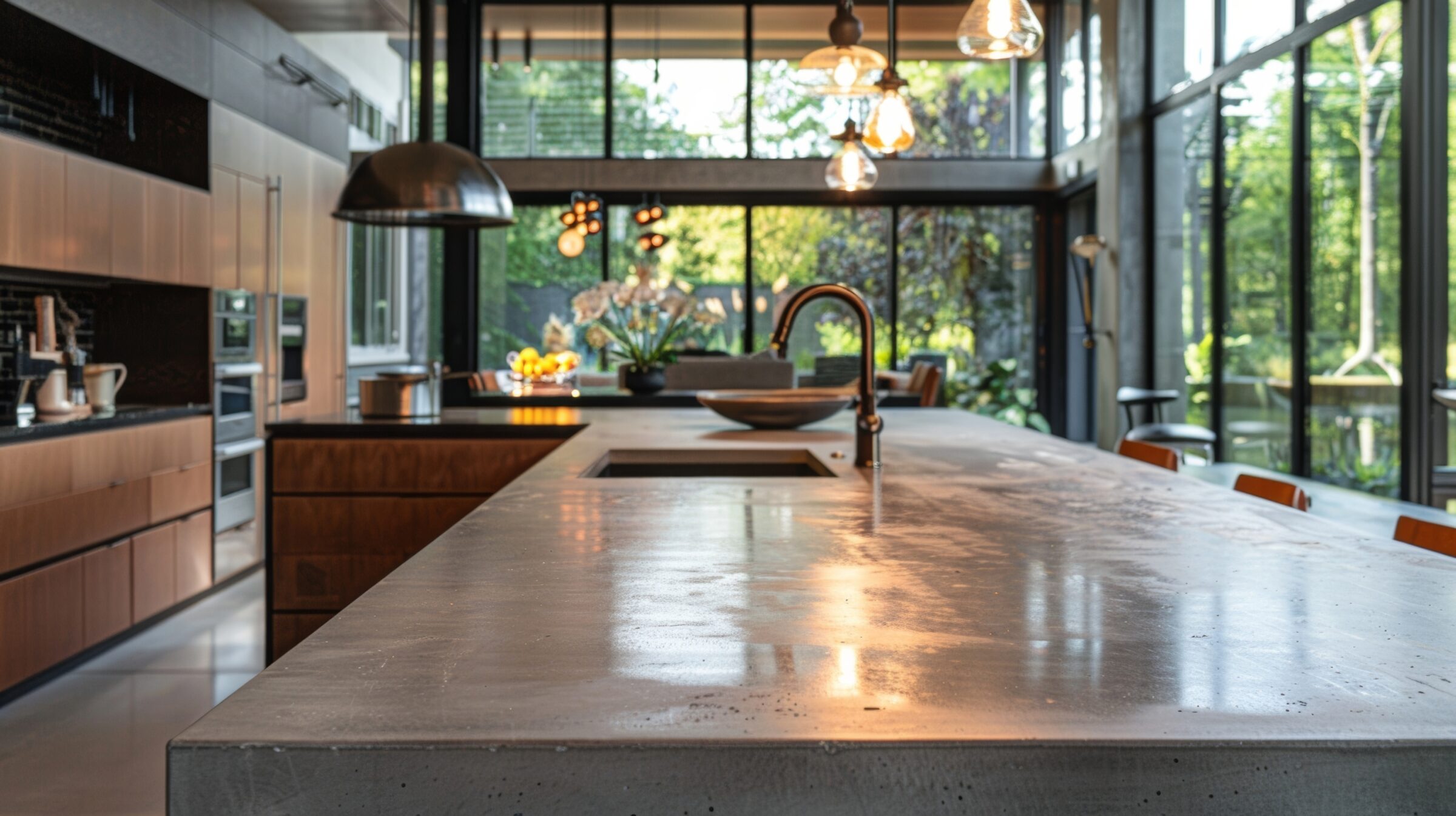How to Create Polished Concrete Kitchens
April 10, 2024

Imagine having a kitchen surface that’s got substance and durability, while also being genuinely beautiful. That’s the possibility of polished concrete – a material that’s typically thought of as a simple construction element. As something that’s also very cost conscious, it’s gaining more and more visibility for kitchen countertops, flooring, and even walls. Polished concrete is especially useful for kitchens because of its resilience and versatility.
They are customizable in terms of shade, finish, and texture, enabling anyone to design a kitchen space that uniquely reflects any desired style. This seamless blend of practicality and design has led to more homeowners wanting a taste of the polished concrete experience.
Planning Your Polished Concrete Kitchen
Creating a polished concrete kitchen means equally polished planning. Knowing the layout is necessary for the direction of the design process. There are options for a transitional vibe, complete with vintage runners and polished concrete floors complimented by a wooden kitchen island. Or, perhaps, the appeal of black Moroccan floor tiles provides strikes the right contrast to concrete countertops and apron sinks.
Polished concrete also reflects light beautifully, enhancing any sunlight streaming through windows or glass lanterns – one more reason to prioritize natural light when planning. But remember, planning based on available light should go hand in hand with selecting the appropriate color palette – from green-glazed grids to white quartz or black kitchen cabinets.
Once the design elements are chosen, it’s time to find the right professionals for the job. Selecting contractors experienced in working with polished concrete is the aim here. Their expertise is invaluable in achieving the right finished product – a kitchen with durability and customizable design that caters to specific needs and aesthetics.
Legal considerations need to be worked into the planning phase as well. Be purposeful about the required permits, regulations, and local building codes. These guarantee the project adheres to legal, health, and safety standards. A thoughtful structural review should also be done prior to installation, making sure the space can handle the weight and installation of concrete surfaces.
Installation Process
Creating an enviable polished concrete kitchen starts with prep. Any pre-existing fittings have to be removed, clearing the site entirely. This is followed by making sure the base where the concrete will be poured is leveled, creating a stable foundation, guaranteeing a smooth installation process.
Pouring the Concrete
Next, the focus is on the process of mixing and pouring. This starts with blending water, aggregates, and cement to form the concrete mix. This stage is crucial in determining the appearance of the concrete, such as its color and texture, by incorporating certain additives. The outcome is a unique and custom-tailored design for every kitchen, reflecting the distinct taste of each homeowner.
The Polishing Process
When the concrete has fully dried, the focus shifts to polishing. This is done with a floor grinder that’s equipped with diamond abrasive discs. By tweaking variables such as the level of grit, the count of polish applications, and the applied pressure, the result can vary. This grants the capacity to attain finishes from a subtle matte to a glossy sheen, exuding a classy and fashionable appeal.
Sealing Concrete
When the perfect shine is reached, the last step is to seal the concrete. This step is often overlooked, but it’s critical in protecting against marks and moisture. Essentially, the sealant serves as a shield for the concrete, ensuring that its sleek look lasts for many years.
Design and Decoration Tips
Integrating polished concrete in a kitchen blends well with other materials. The contrast between the cool concrete and warm wood, such as kitchen cabinets or a rustic island, creates an interesting balance. Similarly, metallic items like stainless steel appliances or brushed nickel faucets, enhance its industrial appeal. The addition of glass components, like a stylish backsplash or vintage lanterns, adds to the layered visuals and brightens area.
Various color schemes and surface finishes can change the kitchen’s atmosphere. Soft neutral colors like beige or white, combined with the grey shades of concrete, create a light, expansive feel. Conversely, the use of darker colors such as black, green, or brown for cabinets offers an eye-catching contrast. Textures like green glazed tile or black Moroccan tile can underscore this, introducing a pleasant contrast against the smooth concrete.
Consider investing time in lighting decisions for a polished concrete kitchen as well. Recessed ceiling lights showcase the concrete’s smoothness, while pendant lights or vintage glass lanterns above islands create warmth. Spotlights can emphasize standout elements like a polished concrete backsplash or countertop.
Maintenance and Care
Keeping a polished concrete kitchen tidy doesn’t need to be difficult. With easy steps, it’s simple to maintain its condition. Regular sweeping and careful stain cleaning, topped off with washing and drying, is all it takes. This routine keeps concrete floors clean and shiny.
Kitchens are high-activity areas where some damage is unavoidable. Addressing these small problems quickly can stop them from escalating. Small cracks can be fixed with a good patching compound, while scratches may just need a little polishing.
At times, concrete floors may lose their shine and display more extensive wear. In these cases, professional re-polishing could be necessary. A key indicator of needing expert assistance is when standard cleaning methods no longer achieve the desired look.
The use of polished concrete in kitchens is a balance of brawn and beauty for contemporary homes. It’s not only durable and customizable with an injection of personal style and character, but it also efficiently uses energy and is easy to maintain. Even with the potential disadvantages like surface cracking and hardness, solutions like proper sealing and repairs will help maintain it. Design-wise, the flexibility to incorporate stains, pigments, and decorative elements like mirror glass allows for a high degree of customization. Given these benefits, polished concrete kitchens are undoubtedly worth considering for anyone aiming to design an efficient, modern home.